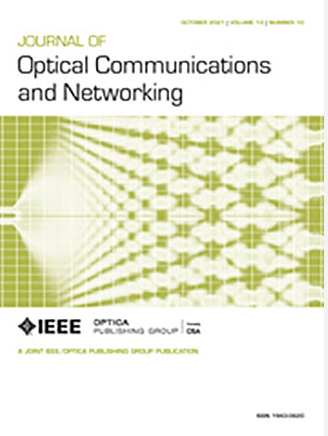Advanced radio-over-fiber interfaces and high-speed optical links toward 6G large-capacity fronthaul networks [Invited]
IF 4.3
2区 计算机科学
Q1 COMPUTER SCIENCE, HARDWARE & ARCHITECTURE
引用次数: 0
Abstract
The exponential growth in mobile data traffic necessitates substantial advancements in fronthaul networks to support next-generation wireless communications. This paper comprehensively reviews two critical aspects for achieving large-capacity fronthaul networks: high-speed optical links and advanced radio-over-fiber (RoF) conversion interfaces. We first overview several fronthaul network architectures, including direct fiber connection, various wavelength-division multiplexing solutions, and point-to-multipoint architectures. Next, we explore optical transceiver modules for fronthaul networks, focusing on the evolution from none-return-to-zero to four-level pulse amplitude modulation format to achieve 50 Gb/s and beyond data rates and the standardization progress of these optical transceiver modules. We then analyze emerging challenges in high-speed optical fronthaul links, particularly chromatic dispersion, multi-path interference, and four-wave mixing, along with their respective mitigation strategies. Furthermore, we review advanced RoF conversion interfaces beyond conventional standardized digital interfaces, including digital RoF with data compression and unequal bit protection, analog RoF with enhanced robustness against noise, and hybrid digital–analog RoF with efficient signal-to-noise ratio scaling and low-complexity implementation. These technologies collectively enable the development of large-capacity fronthaul networks essential for supporting future 6G wireless communications.面向6G大容量前传网络的先进光纤无线接口和高速光链路[特邀]
移动数据流量的指数级增长需要前传网络的实质性进步,以支持下一代无线通信。本文全面评述了实现大容量前传网络的两个关键方面:高速光链路和先进的光纤无线电(RoF)转换接口。我们首先概述了几种前传网络架构,包括直接光纤连接、各种波分复用解决方案和点对多点架构。接下来,我们探讨了前传网络的光模块,重点研究了从无归零到四电平脉冲调幅格式的演变,以实现50 Gb/s及以上的数据速率,以及这些光模块的标准化进展。然后,我们分析了高速光学前传链路中出现的新挑战,特别是色散、多径干扰和四波混频,以及它们各自的缓解策略。此外,我们回顾了超越传统标准化数字接口的先进RoF转换接口,包括具有数据压缩和非等位保护的数字RoF,具有增强抗噪声鲁棒性的模拟RoF,以及具有有效信噪比缩放和低复杂度实现的混合数模RoF。这些技术共同推动了支持未来6G无线通信的大容量前传网络的发展。
本文章由计算机程序翻译,如有差异,请以英文原文为准。
求助全文
约1分钟内获得全文
求助全文
来源期刊
CiteScore
9.40
自引率
16.00%
发文量
104
审稿时长
4 months
期刊介绍:
The scope of the Journal includes advances in the state-of-the-art of optical networking science, technology, and engineering. Both theoretical contributions (including new techniques, concepts, analyses, and economic studies) and practical contributions (including optical networking experiments, prototypes, and new applications) are encouraged. Subareas of interest include the architecture and design of optical networks, optical network survivability and security, software-defined optical networking, elastic optical networks, data and control plane advances, network management related innovation, and optical access networks. Enabling technologies and their applications are suitable topics only if the results are shown to directly impact optical networking beyond simple point-to-point networks.

 求助内容:
求助内容: 应助结果提醒方式:
应助结果提醒方式:


